The Divine Plan and Incarnation
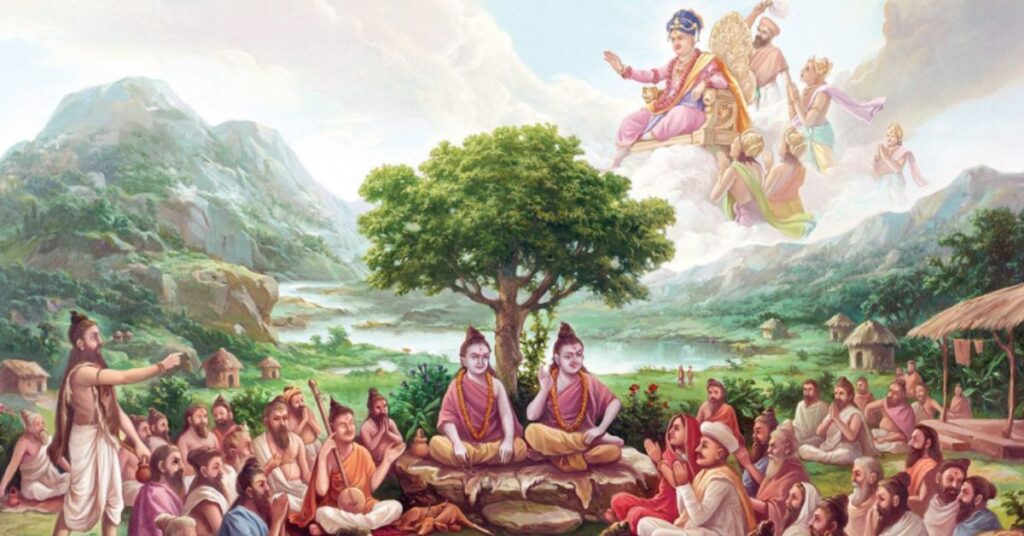
The genesis of Bhagwan Shree Swaminarayan’s earthly manifestation began at Badrikashram, where Bhagwan Shree Narnarayan was holding a sabha. In attendance were revered figures such as Dharma, Bhakti, and Uddhavji. Their profound absorption in the katha led them to inadvertently overlook the arrival of Durvasa Rishi. Angered by this perceived slight, Durvasa Rishi gave a shaap (curse), condemning all those who were present in the sahba to be born on Earth and endure suffering at the hands of demonic forces. However, this was, in essence, a divine episode orchestrated by Bhagwan Himself. Reassuring everyone, Bhagwan Narnarayan instructed Dharma and Bhakti to prepare, promising to incarnate as their son.
Birth and Early Life of Ghanshyam
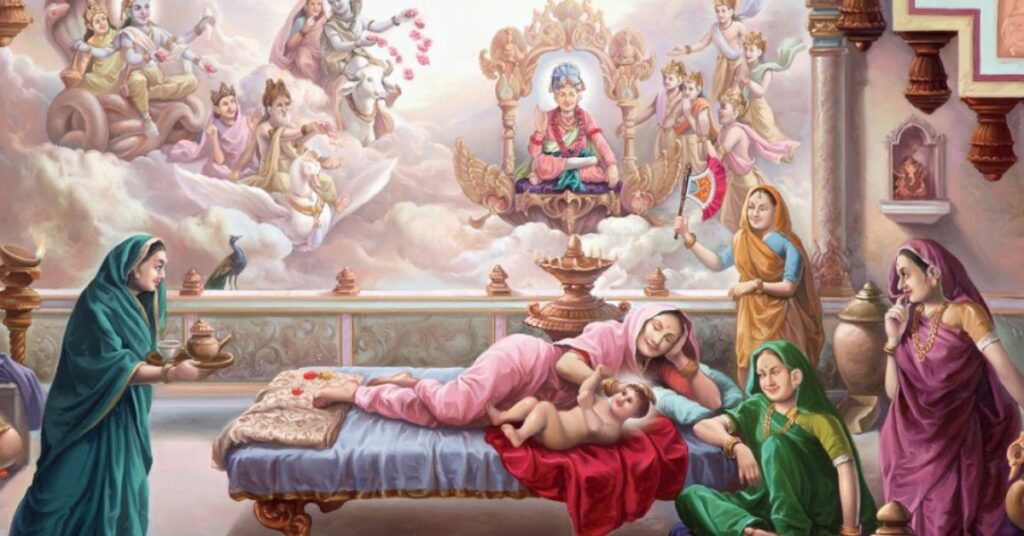
True to the divine promise, Bhagwan Shree Swaminarayan was born as Ghanshyam to Dharmadev and Bhaktimata in Chhapaiya, Uttar Pradesh, India, on Chaitra Sud 9, V.S. 1837 (April 3, 1781), at 10:10 PM. He had two brothers: an elder by 19 years, Rampratapbhai, and a younger by 5 years, Ichharamji. On the sixth day after his birth, Markandeya Rishi bestowed upon him three names: Hari, Krishna, and Harikrishna. The residents of Chhapaiya lovingly added another name, Ghanshyam. By the tender age of seven, Ghanshyam had mastered all branches of knowledge from his father, delving deep into various religious scriptures and literature. He even summarized these extensive texts into a concise personal book, which he called “Gutko.”
Following the worldly departure of his mother, Bhaktimata, and then his father (7 months later), Dharmadev, Ghanshyam (at the age of 10) diligently fulfilled his final duties until their last moments. Only after honoring his responsibilities to his parents did he embark upon the true mission of his incarnation.
Nilkanth Varni’s Van Vicharan

At the age of 11 years, 3 months, and 1 day, Ghanshyam renounced His home to begin His divine journey across the Indian subcontinent, known as Van Vicharan. He carried only a few essentials: a Shaligram (for worship), a mala (rosary), his small book (Gutko), a water pot (Kamandal), and minimal clothing (Kopin).
His path led him first to the Himalayas, where he performed rigorous penance for 4 months and graced hundreds of thousands of Rishis (approximately 900,000) with His darshan. He then continued his journey across East and South India, visiting numerous sacred sites, ashrams, and even perilous locations. During this period, he dedicated Himself to re-establishing righteous religious and social values. It was during his Van-Vicharan that he met Gopal Yogi, from whom he learned and mastered Ashtang Yoga (8 fold yoga). He was also given the name ‘Nilkanth Varni’ during this transformative period. After seven years, one month, and eleven days of continuous travel, Bhagwan, as Nilkanth Varni, finally arrived in Loj, Gujarat.
The Arrival in Loj and Meeting Muktanand Swami
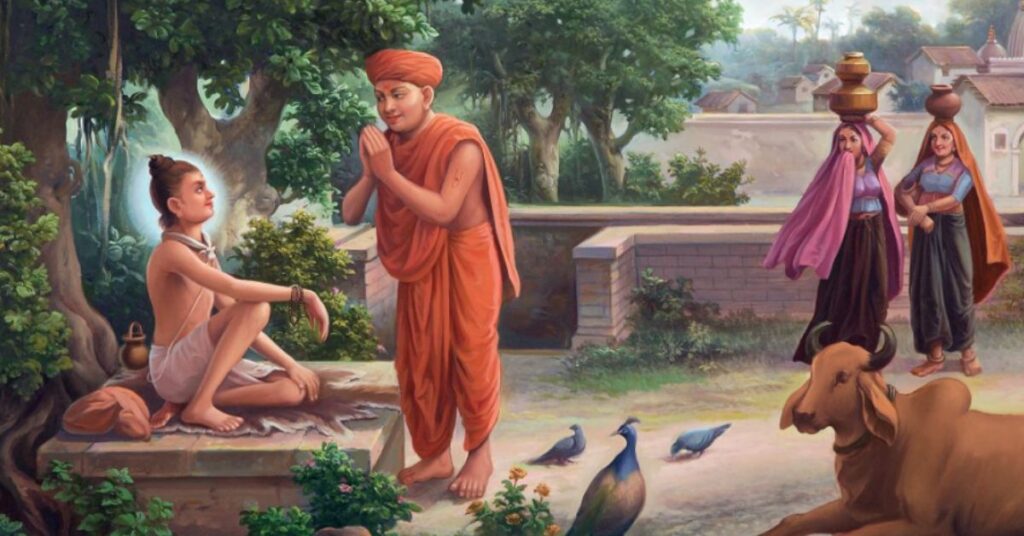
In Loj, there stood an ashram founded by Sadguru Shree Ramanand Swami (reincarnation of Uddhavji and head of the Uddhav Sampraday). One morning, at the village’s step-well (vav), the local women and Shukanand Swami caught sight of Bhagwan (Nilkanth Varni). Shukanand Swami, a devoted disciple of Ramanand Swami, respectfully invited Nilkanth Varni and escorted him to the ashram. Ramanand Swami was in Bhuj at the time, but Muktanand Swami, the senior-most disciple of Ramanand Swami, extended a warm welcome.
Before deciding to reside there, Varniraj posed five profound questions to ascertain if this was indeed His destined place and if Muktanand Swami’s guru was His destined guru. The questions were: “What are Jiv, Ishwar, Maya, Brahm, and Parabrahm?” Muktanand Swami, speaking on behalf of his guru Ramanand Swami, answered all the questions to Varniraj’s complete satisfaction. Muktanand Swami answered, “Jiv is the eternal soul that cannot be destroyed, Ishwar is the form of Demigod, Maya is the force of God distracting one’s devotion, Brahm is the jiv that has achieved salvation, and Parabrahm is the Almighty God Supreme Himself.”
Convinced, Varniraj decided to stay and was given another name by Muktanand Swami: Sarjudas. He eagerly awaited the arrival of Ramanand Swami. Muktanand Swami and Varniraj both penned separate letters to Ramanand Swami, who was in Bhuj at the time. Mayaram Bhatt took it upon himself to deliver the letters from Loj to Bhuj. Upon receiving them, Ramanand Swami was filled with joy, anticipating the completion of his responsibilities and Bhagwan’s succession. Ramanand Swami replied, promising to meet them in Piplana in a few months.
Even as Parabrahm Purushottam Narayan, Sarjudas humbly displayed the exemplary qualities of an ideal disciple. At the ashram in Loj, Sarjudas diligently performed many humble duties, including cleaning the premises, collecting cow dung for fuel, and feeding the poor. He also generously imparted His knowledge of yoga to all the disciples of the ashram.
Meeting in Piplana
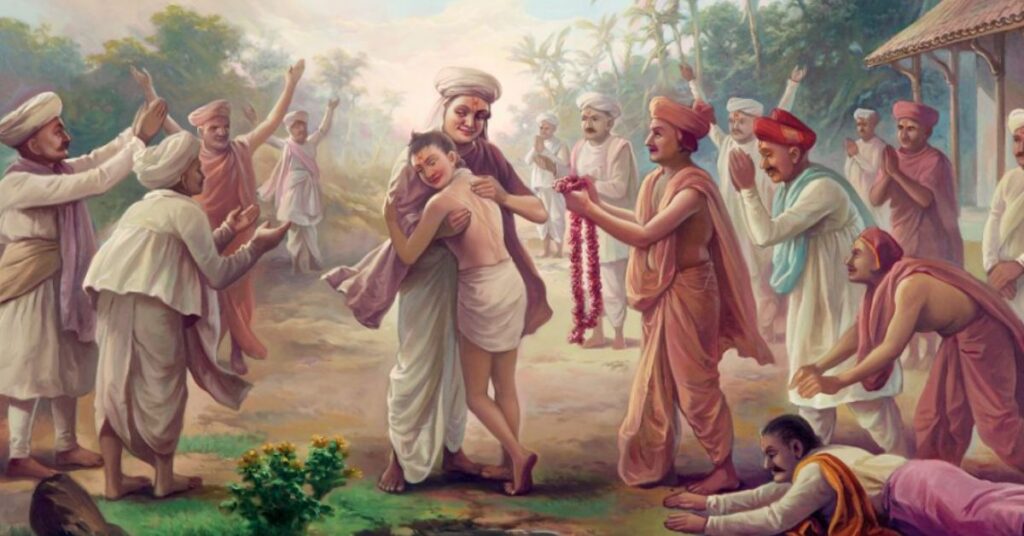
After a nine-month stay in Loj, Sarjudas received an anticipated message from Ramanand Swami, delivered by the devotee Kunverjibhai. Ramanand Swami requested Sarjudas, Muktanand Swami, and other saints and devotees to meet him in Piplana, near Junagadh.
Sarjudas, Muktanand Swami, and the others arrived in Piplana on the 12th day of the dark half of the month Jeth, Vikram Samvat 1856. They met Ramanand Swami at the residence of Narsinh Mehta.
Upon seeing Sarjudas, Ramanand Swami immediately rose, extending a heartfelt and loving embrace. He instantly recognized Sarjudas as Parabrahm Purushottam Narayan (Almighty God Supreme). Ramanand Swami then inquired about Sarjudas’s parents, His childhood, and the van vicharan that had ultimately led Him to Loj.
Diksha and Gadi Abhishek
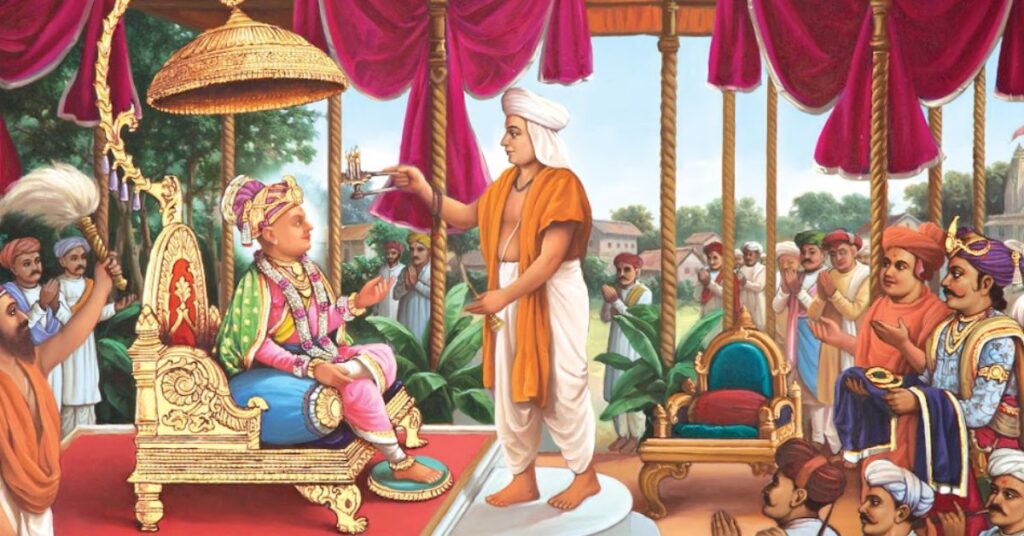
5 Months later, Ramanand Swami formally initiated Sarjudas in Piplana on Prabodhini Ekadashi V.S. 1857 (1800 C.E.), becoming his guru and bestowing upon him two new names: Sahajanand Swami and Narayan Muni.
Exactly 1 year later, Ramanand Swami subsequently decided to entrust his entire spiritual establishment to Sahajanand Swami. A grand ceremony was meticulously planned in Jetpur, where, at the age of 20, Sahajanand Swami was formally installed as the head of the Uddhav Sampraday. Sahajanand Swami told Ramanand Swami that He would only agree enthrone the Uddhav Sampraday upon 2 conditions:
- “If a follower of the Sampraday suffers pain to the likes of a scorpion sting, that pain must befall on Me millions upon millions of times, but the satsangi of this Sampraday should not be harmed.”
- “If a follower of the Sampraday has to suffer hardship of getting food and clothes and has to constantly beg, I beg those hardships fall on Me such that the satsangi get food and clothes easily.”
Ramanand Swami was moved to tears upon these vardans (boons) and granted them nonetheless. This Lila (divine episode) shows the love that Sahajanand Swami has for His devotees.
Birth of the Swaminarayan Mahamantra
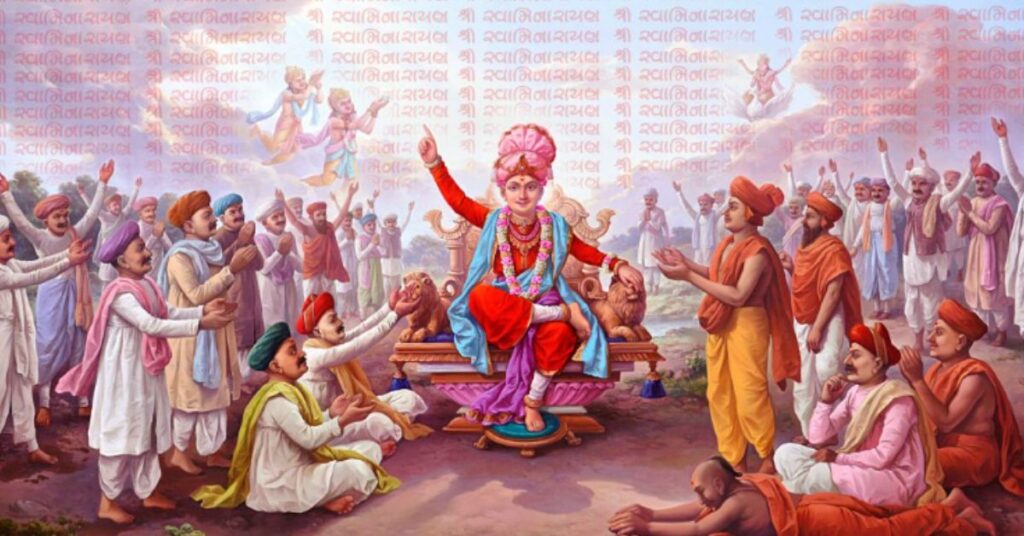
One month and one day later, in Fareni, Ramanand Swami departed his mortal body and ascended to Akshardham. On the fourteenth day following Ramanand Swami’s departure, Sahajanand Swami convened a grand sabha and instructed everyone to chant a single name – “Swaminarayan.” As they chanted, all of those who were present entered a state of samadhi (deep meditative trance), witnessing their own preferred deity within Sahajanand Swami Himself. This unique and extraordinary manifestation undeniably affirmed Sahajanand Swami as Purna Purushottam Narayan.
Thus, on the fourteenth day after Ramanand Swami’s demise, Sahajanand Swami declared his own name as “Swaminarayan” and renamed the Uddhav Sampraday as the Swaminarayan Sampraday. Because Bhagwan himself chose the name “Swaminarayan,” it carries immense power. It is not merely a name but a potent “Mahamantra”.
It should be noted that ‘Swaminarayan’ is one word:
‘Swami’ denotes all-understanding or omnipresent (adjective describing Narayan)
‘Narayan’ denotes Purna Purushottam
Hence, ‘Swaminarayan’ translate to the Supreme Lord
Legacy and Teachings
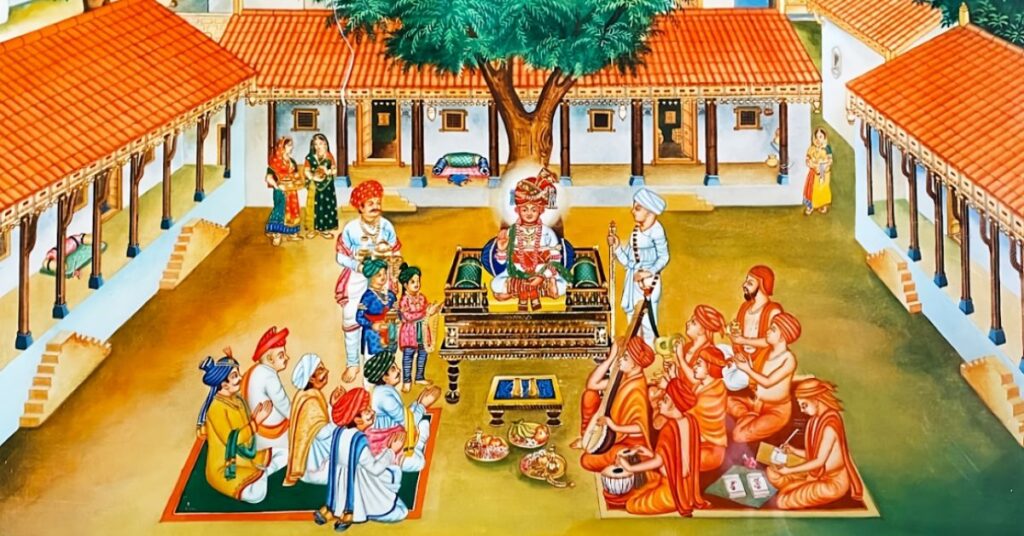
Following these pivotal events, Bhagwan Shree Swaminarayan and his devoted saints (Paramhanso) continued their vicharan across Gujarat, tirelessly propagating Dharma, Bhakti, Gnan, and Vairagya. During these vicharans, Bhagwan Shree Swaminarayan performed numerous Lilas which further solidified the faith of His devotees. Many of His profound teachings are meticulously compiled in the sacred text known as the “Vachanamrut.” Sadguru Shree Shatanand Swami has documented Bhagwan Shree Swaminarayan’s entire life in the biography “Shreemad Satsangi Jivan”, a scripture which Bhagwan Shree Swaminarayan has carried upon His head. Throughout his Earthly existence, Bhagwan Shree Swaminarayan also oversaw the construction of six magnificent temples (Ahmedabad, Bhuj, Vadtal, Dholera, Junagadh, Gadhada).
Establishing the Sampraday’s Future
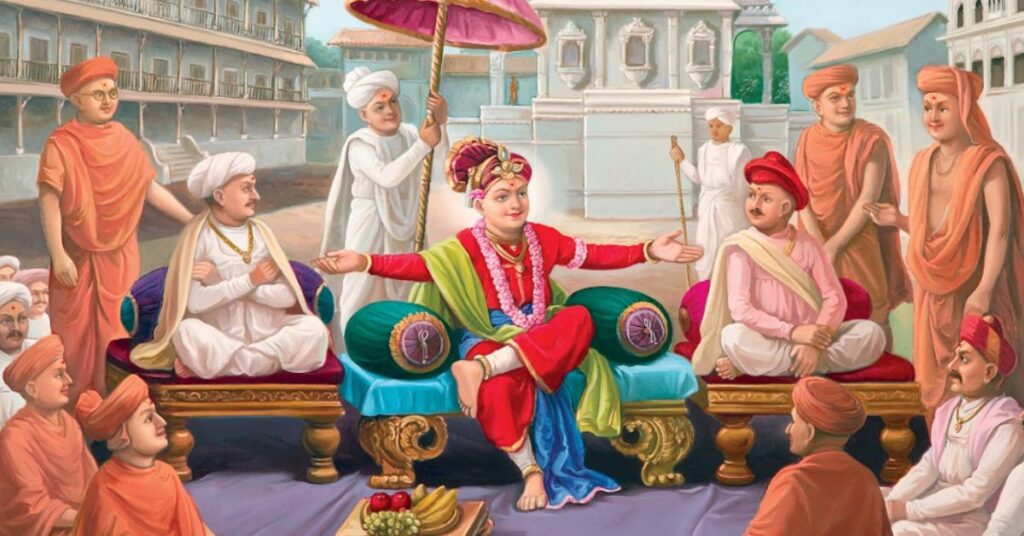
When Bhagwan Shree Swaminarayan determined that He had accomplished His divine mission on Earth and that it was time to return to His heavenly abode of Akshardham, He ensured the continued prosperity of the Sampraday. He established two dioceses and a six-pillared structure for the Sampraday, encompassing Bhagwan, Acharya, Shastras, Mandir, Santo (saints), and Haribhakto (devotees). He ensured everyone that He will forever reside in each of the 6 pillars. Bhagwan Shree Swaminarayan’s final wishes and instructions are engraved in “Desh Vibhag no Lekh.” This crucial document delineates the “Acharya Parampara” (lineage of gurus and acharyas), which Bhagwan Shree Swaminarayan explicitly instructed his followers to adhere to in order to be considered true adherents of the Swaminarayan Sampraday.